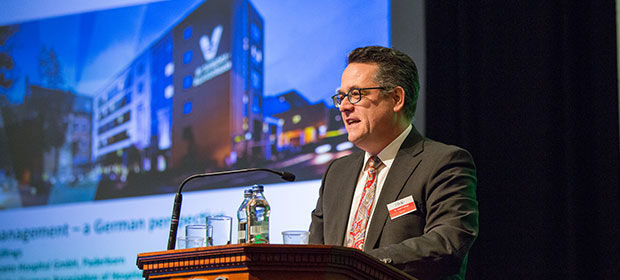Germany’s health service challenges centred not on a shortage of services but rather an over-supply of services, Dr. Josef Dullings President of the German Association of Hospital Managers (VKD) and CEO, Hospitals of Saint Vincenz, Paderborn, Germany told the Conference.

He was speaking on “Lean management: A German perspective.”
Dr. Dullings said that Germany, with a population of 82 million, had 1,600 acute care hospitals, half of which had fewer than 250 beds. The hospitals cared for 19 million inpatients annually – 23% of the population.
The hospitals had a total of 1.2 million employees and a turnover of €100 billion. Germany had a universal multi-payer system, with a dual financing hospital system provided by statutory health insurance known as sickness funds and private health insurance. Ambulatory care was provided outside of hospitals.
The Hospitals of Saint Vincenz were founded by the Daughters of Charity of St. Vincent de Paul in 1901. The three hospitals provided 756 beds and included a women and children’s hospital, 16 special clinics, eight centres and three centres of affiliated physicians, which provided care annually for 45,000 inpatients, 80,000 outpatients and 3,000 Births. The hospitals had 2,200 employees and an annual turnover of €160 million. As a charitable hospital Saint Vincenz had to make profit to make investments.
He said there were no shortages on health services in Germany. Rather the country had an oversupply of services. The Federal Government believed that the country had too many acute beds and wanted the number reduced. There were economic pressure on hospitals, people had very high expectations of the care they would receive and there were enormous pressures on staff to be economically efficient.
The way to cope with these expectations was to provide the best quality of medicine and nursing care, delivered with the highest efficiency and resulting in the highest patient satisfaction.
There were economic pressure on hospitals, people had very high expectations of the care they would receive and there were enormous pressures on staff to be economically efficient.
Dr. Dullings said the main focus in hospitals was on quality improvement. He would describe the German hospitals as structure organisations, when they should be process organisations.
He used a coffee service to illustrate the difference between a structure organisation and a process organisation. He said that in a structure organisation, one department was responsible for the first part of the process – making the coffee and adding the milk. There was then a break in the process and another department was responsible for stirring and serving the coffee.
When you applied this to patients, it meant they had to move across this break between the two departments and the question was how to change a structure organisation into a process organisation, where there would be no break between the two processes.
This would result in better patient satisfaction, lower staff frustration and financial savings.
He said deficiencies of the structure organisation included patients having to move across interfaces, waiting times, the risk of error, loss of information, loss of patient focus, lower quality of care, lower patient satisfaction and waste.
The process organisation would result in a constant and higher quality of care, a reduction of waiting times, a reduction in risk of error, cost reduction, reduction of material costs, the potential for additional patients and lower frustration for employees.
Dr. Dullings said that in his hospital, discussion about lean management started in 2014. In 2015, the first projects were begun in the accounting department, internal medicine and paediatrics . The implementation in clinics and departments was accelerated in 2016, when projects were started in each clinic and departments, with good results for patient care and cost saving.
For example, the throughput time for emergency room outpatient visits declined from January to September from 3 hours to two hours.

